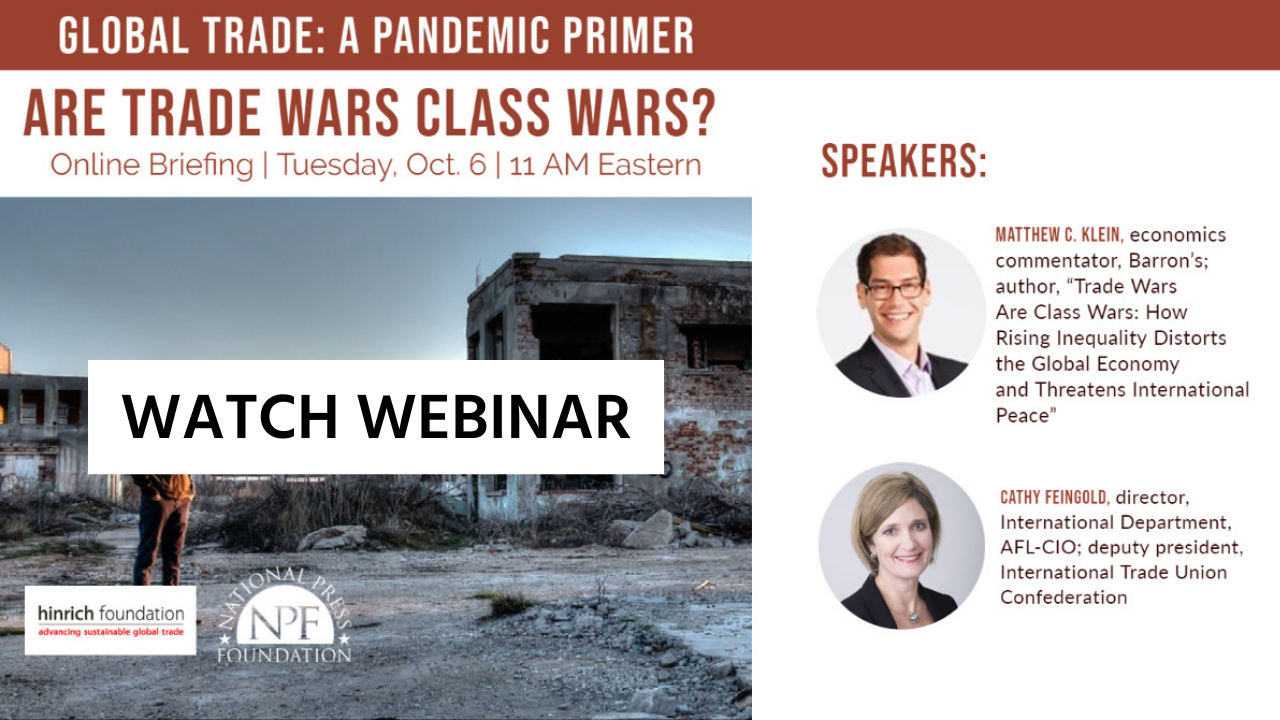Enforcing US trade laws in a global market
Published 20 April 2021
How is the US enforcing its trade laws internationally to ensure imported goods have not violated American labor and environmental regulations? Three speakers discussed the work of US Customs and Border Protection, forced labor in Xinjiang, and global supply chain traceability.
In this fifth installment of the National Press Foundation series on global trade, supported by the Hinrich Foundation, three speakers were invited to explore the US global enforcement of its trade regulations, the labor situation in China's Muslim-majority Xinjiang province, and the struggle multinationals face when separating themselves from bad actors. Here are five key takeaways:
- Without trust in the safety and security of imported goods, the US economy and citizens won’t benefit from international trade. US Customs and Border Protection is charged with regulating $4 trillion in annual trade and travelers passing through 300 points of entry. The US Customs Service was founded in 1789 to collect duties to pay off Revolutionary War debts and now collects $80 billion in import and export duties. CBP’s 60,000 employees are also charged with stopping imports of contraband that includes counterfeit goods, conflict diamonds, and cotton or tomatoes picked by Uyghur Muslims in Chinese detention camps. It also polices human trafficking. The agency is on the front lines of ensuring that products that reach US consumers are not made with forced labor, child labor or environmental violations. CBP must also monitor imports arriving in increasingly small shipments to key e-commerce hubs for the major US delivery companies in Cincinnati, Indianapolis, Memphis and Louisville, as well as ports on the West Coast.
- The pandemic has opened Americans’ eyes to some of the hazards of ill-regulated trade. That includes fake e-commerce platforms, counterfeit masks and latex gloves made in Malaysia by workers in horrific conditions. Brenda Smith, who served as Executive Assistant Commissioner for Trade at CBP until her retirement in March, was one of America’s top trade enforcement officials. She said CBP now uses a risk model to identify likely trade offenders, powered by vast troves of data collected over the past 30 years. It also deploys advanced analytics to spot trends and anomalies and improving technologies for detection. The genetic and geographic origins of many products can now be traced with enormous precision, Smith said, but doing such detection at scale and at low cost remains a challenge.
- Uyghurs are being used as forced laborers across China, not just in Xinjiang. Alim Seytoff, head of the Uyghur Service of Radio Free Asia, said Chinese companies began to build textile and other factories very close to the detention camp compounds built starting in 2017. “There were a number of Chinese companies set up to produce human hair. We did a thorough investigation and realized these hairs came from Uyghur detainees from the camps,” he said. Long hair cut from Uyghur women was sent to “Chinese factories that [are] hiring thousands of people to process and produce the hair, shipped to other parts of China and then they export to the US, Europe and other countries,” he said. In 2020, CBP issued “Withhold Release Orders “ to seize shipments of Chinese hair and wig producers. (Journalists can get alerts about CBP enforcement actions by signing up here. Other websites and resources for journalists are here.)
- During the pandemic, Uyghurs were trafficked to private companies, making them harder to trace. Seytoff said hundreds or thousands of young Uyghurs were sent from Xinjiang to other parts of China as forced laborers for private Chinese companies. “They were basically advertising, “We have 200 Uyghur women. Any company wants it, we can ship them… And they will just work 10, 12 hours a day,” Seytoff said. Because these companies are dispersed, they are harder to trace, though journalists have been able to find survivors through social media and relatives who have fled. Still, more than 80 brands have been implicated in hiring suppliers who used such labor, Seytoff said. This has created a crisis for global brands that want to rid themselves of Xinjiang cotton and other products made with the taint of forced labor but face a backlash from nationalist Chinese if they do.
- It’s a struggle for law-abiding companies that are trying to separate themselves from bad actors with environmental and labor violations in their supply chains. “You really want to create a fairly big differential between those who obey the law and those who are insistent on evading the law,” said Stephen Lamar, president and CEO of the American Apparel & Footwear Association. “It’s important that there is this partnership with trusted traders, but it should be reinforced that this is a constant struggle. Those who profit from human trafficking and forced labor are constantly looking for ways to evade enforcement. And they’re very inventive. And so, it’s up to us to be equally creative and stay a couple of steps ahead of them.”
***
This briefing is part of a series of National Press Foundation's online webinars on global trade issues in the era of the coronavirus. Check here for all past briefings.
© The Hinrich Foundation. See our website Terms and conditions for our copyright and reprint policy. All statements of fact and the views, conclusions and recommendations expressed in this publication are the sole responsibility of the author(s).















